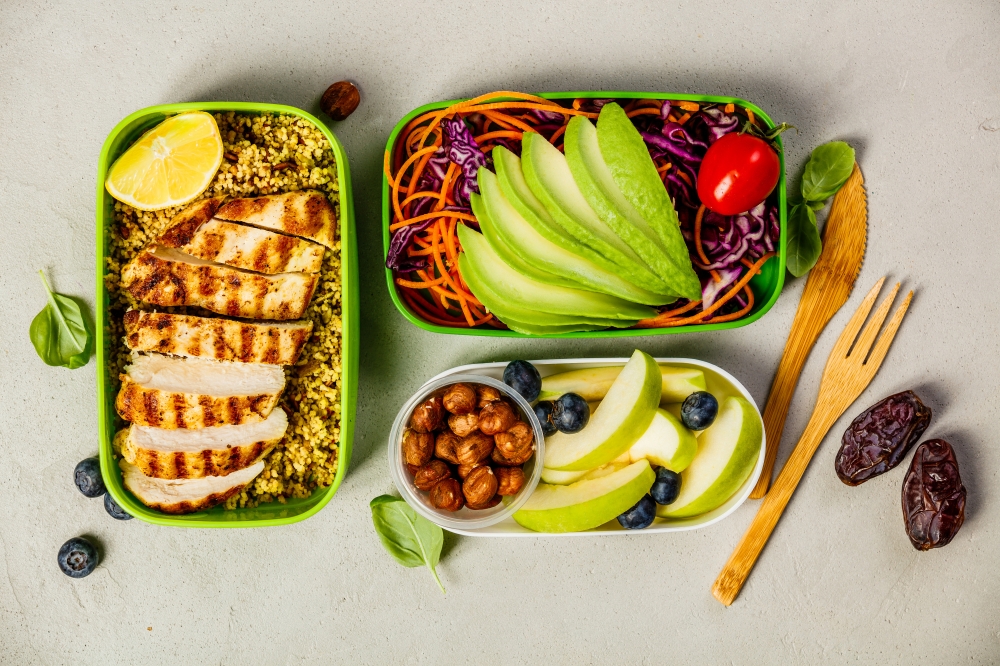The key to a healthy lunchbox lies in striking the right balance between taste and nutrition. It is not about restricting your family’s preferences or depriving them of treats, but rather about making informed decisions that optimise their wellbeing, whilst being true to your own family’s values (your culture, family traditions, food origins, availability and access, and what brings you joy!). By incorporating fresh fruits, vegetables, whole grains, quality proteins, and healthy fats, we can create meals that provide sustained energy, support brain function, and boost the immune system.
The Simple Lunchbox Checklist is easy to remember – ensure your lunchbox includes Protein, Fibre, Healthy Fats and Colour and you’re on your way to a balanced lunchbox that will help fuel your family for their day of learning, growing, moving, thinking and balancing all the balls you have in the air!
Macronutrients:
Macronutrients are the main component of our tissues and are required in large amount. Macronutrients include protein, carbohydrates, fats and offer fuel for us to function and grow.
Protein:
What it does: Protein is involved in every process in the body. We need protein for all of our cells to grow, repair and function. It’s key to building muscles, our metabolism and maintaining a strong immune system. It also helps keep us fuller for longer.
Where you’ll find it: In all foods, but rich sources are found in meat, and other animal products such as dairy and eggs, legumes, beans and pulses, grains, nuts and seeds.
How to include it:
- Add grilled meats or beans (whole soaked beans or bean-based dips such as hummus) to salads and wraps
- Choose higher protein grains to serve with meals such as quinoa, oatmeal, buckwheat and teff)
- Add yoghurt, nut butters & seeds to smoothies, porridge and fruit slices.
- Use legume flour for baking (chickpea flour)
- Snack on boiled eggs, yoghurt and homemade trail mixes for filling lunchbox additions
- Check out our free Protein Handout dowload for some more ideas.
Complex Carbohydrates + Fibre:
What it does: Complex carbohydrates have a more complex structure as the name suggests. They take longer to digest and break down into smaller molecules, so they provide more lasting energy and a more gradual effect on blood sugar levels. It keeps you feeling fuller, sooner. Fibres are plant based complex carbohydrates that are not able to be digested by the intestine. There are two types of fibre; soluble fibre draws water into the stool making them softer and easier to pass. Insoluble: adds bulk to the poo, helping it to move more quickly and smoothly through the intestine.
Where you’ll find it: Whole fruit, whole grains, beans, legumes, seeds
How to include it:
- Leave skin on fruits and vegetables where possible
- Choose wholegrain or legume-based pasta, bread and wraps
- Add beans and legumes to soups, stews and salads
- Add some crunch and flavour to salads, soups and roasted vegetables by serving sprinkled with chopped nuts and seeds
- Blend beans and legumes with roasted vegetables and yoghurt for a quick dip to serve with vegetables
- Serve porridge, yoghurt, smoothies and fruit sprinkled with chopped nuts or seeds
Fat:
What is does: Dietary fats are essential as a fuel source and for the health and function of our cells. Fats provide insulation and protection for our organs, and dietary fats are required for the absorption of fat soluble vitamins including A, D, E and K.
Where you’ll find it: Avocado, coconut oil, nuts, seeds, olive oil, dairy
How to include it:
- Use avocado as a spread or dip
- Blend avocado, nuts or seeds into smoothies, porridge or desserts
- Dress salads with good oils (olive, avocado, flaxseed)
- Drizzle olive oil over soups, risottos and steamed vegetables
Micronutrients + Colour:
Micronutrients are required in smaller amounts but are essential for the intricate functioning of the different systems of our bodies. Micronutrients include vitamins and minerals.
Phytonutrients are natural chemicals or compounds produced by plants which can give them their signature colours. They are protective the agents that help deter insects and other predators, or from the harmful effects of the sun. These actions can also have similar effects in humans, particularly anti-inflammatory and antioxidant actions.
What they do: Vitamins are organic compounds that our bodies use, in very small amounts for a variety of metabolic processes – growth, development, immune function, repair, detoxification, digestion, elimination, reproduction… Minerals are elements on the earth and in the food we eat that our bodies need to develop and function normally.
Where you’ll find it: In all the rainbow of colour you’ll find fruits and vegetables
How to include it:
- Eat the rainbow everyday: red, orange, yellow, green, purple, pink, white and brown
- Pre-chop vegies at the start of the week to add into cooking such as sauce bases or stir-fries, to serve with dips, add to rice paper rolls or salads
- Aim for a few different colours at every meal and snack to add to a rainbow a day
- Work towards incorporating 30 plant-based foods into your weekly meals and snacks for nutrient and fibre diversity and a happy, healthy gut!

